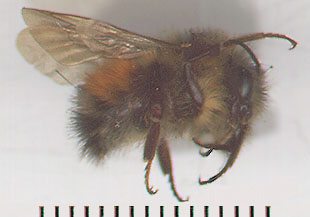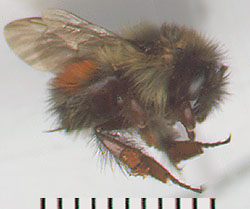


Edmonds, WA, 9 June 2005. © Rick Batchelor
BUG OF THE MONTH: May 1993
Orange-Rumped Bumble Bee
Bombus melanopygus
Order Hymenoptera, Family Apidae
Copyright © 1996 by Louise Kulzer
This article originally appeared in Scarabogram, May 1993, New Series No. 157, p. 2.
Bumble bees fly remarkably early in spring, in temperatures that seem much too frigid for cold-blooded critters. These early individuals are invariably queens which overwintered. A little cold's nothing to them. They've got to gather nectar and pollen, build a nest, lay eggs, and get things rolling! Besides, all that hair must help a little. I've seen bumble bees walk along the ground vibrating their wings just as moths do, apparently to warm up their flight muscles.
 |
| B. melanopygus queen with 15 mm scale |

|
| B. melanopygus worker with 10 mm scale |
 |
| Worker as prey of Misumena vatia Edmonds, WA, 9 June 2005. © Rick Batchelor |
In the Seattle area, females of Bombus melanopygus are easily told from other bumble bees by their general yellowish color (as opposed to blackish) and the bright orange band on the abdomen. Apparently, males lack the orange. Actually, it's not quite so easy, and a key by W.P. Stephen published in 1957 by Oregon State University identifies no less than seven other females in western North America which also have orange on the rump. If it were easy, I'd tell you, but it's not so I won't.
Believe it or not, there is a robber fly mimic of B. melanopygus (or similar orange-rumped bumble bees) that also has an orange band on the abdomen. I've only observed this robber fly at higher elevations in the Cascades, but it may be in the Puget Sound area too. Keep an eye open and you'll soon be picking B. melanopygus out of the local bumble bee crowd (with minor uncertainty).
[Editor's additional info: Bombus melanopygus is found from northernmost California to southern B.C. Queens fly from early April, workers from June to September. Remarkably little is published on the general biology of this species, though some not-too-illuminating experimental studies have shown (for example) what happens when you turn a flower around while the bee is on it (Pyke & Cartar 1992; the bee flew on as if nothing had happened) or when you clip a bee's wings (Cartar 1992; the bee's life span was shortened! Amazing!).]
See this article if you'd like to build a bumble bee house in your yard!
References
Cartar, R.V. 1992. Morphological senescence and longevity: an experiment relating wing wear and life span in foraging wild bumble bees. Journal of Animal Ecology, 61(1): 225-231
Pyke, G.H., & R.V. Cartar. 1992. The flight directionality of bumble bees: Do they remember where they came from? Oikos, 65(2): 321-327.
Stephen, W. P. 1957. Bumble Bees of Western America. Oregon State College, Agricultural Experiment Station, Technical Bulletin 40, 163 pp.
This page last updated 26 July, 2005